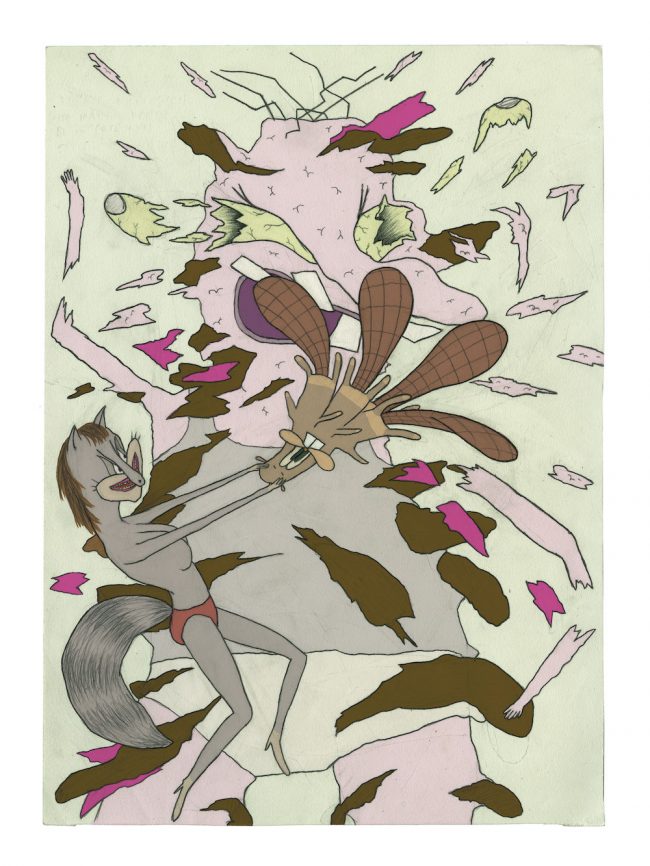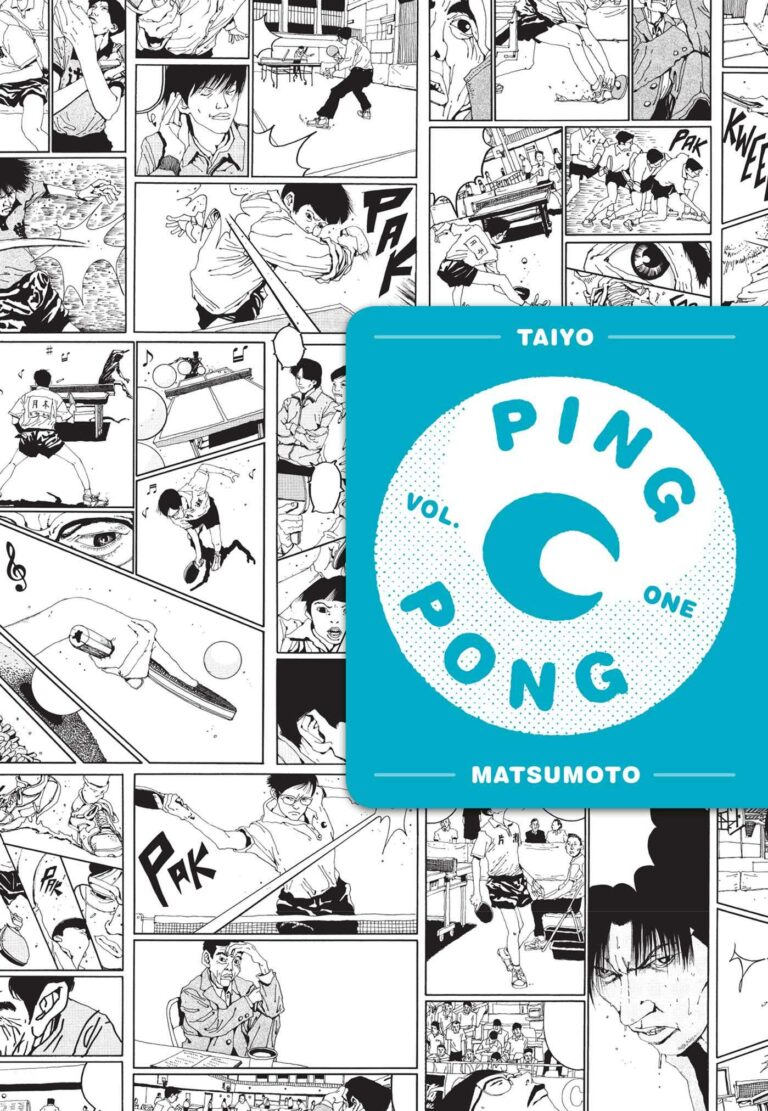“Eek! An Elaborate Misunderstanding Fueled by Pride and The Fear of Rejection.”
This synopsis, voiced during this story’s chaotic apex by the character Bangskank, (presumably a raccoon) neatly surmises the cascading narrative still in the midst of unfurling in Amy Lockhart’s Ditch Life, released late last year from Fantagraphics’ F.U. (Fantagraphics Underground) imprint.
Though this is her first long-form comics release, Amy Lockhart’s aesthetic and quirky world building has long been established through her extensive catalogue of paintings, zines, short films and animation work. Her distinct brand of cartooning is featured extensively in the seminal collection of ‘Canadian Psychedoolia’ Nog-A-Dod. Her two live action shorts featuring Miss Edmonton Teen Burger 1983 are profoundly bizarre, crafty and hilarious and are a must-watch for any appreciator of independent comics and DIY. Her short comic The Dizzler in 2007’s issue of The Ganzfeld is a longtime favorite - a primer to the distinct visual approach, humor and depiction of interpersonal drama that permeates through the pages of her new release, Ditch Life.
A tale ripe with misunderstanding and betrayal purported by conniving ditch-dwellers both humanoid and animal, Ditch Life’s major protagonist Barb is only looking for acceptance and admiration from society and unconditional love at home. On a mission to rise from the dirt into the greater world, she is met with adversity and violent physical dangers at almost every juncture.
Her ditch mate, introduced as Barb’s gremlin, is called Mitch and acts from almost beginning to end as Barb’s foil, continuously undermining and disparaging Barb’s best efforts and subjecting her to unfettered abuse both psychically and mentally.
 His early transgressions seemed designed to keep Barb face-down in ditch-dirt but quickly escalate into conspiring and manipulating events behind the scenes in order to send Barb headfirst into major public embarrassment. Despite Mitch’s campaign to belittle and control her, Barb carries on, actively trying to better her situation and rise from ditch life into greener pastures.
His early transgressions seemed designed to keep Barb face-down in ditch-dirt but quickly escalate into conspiring and manipulating events behind the scenes in order to send Barb headfirst into major public embarrassment. Despite Mitch’s campaign to belittle and control her, Barb carries on, actively trying to better her situation and rise from ditch life into greener pastures.
Similarly to some of Lockhart’s previous works, Ditch Life matter-of-factly goes to extreme and unexpected places. The world we’re introduced to is zany and fueled by cartoon-logic. Characters and objects appear and disappear spontaneously, survive and bounce back from catastrophic injury and are perpetually being resized to suit situations or spaces. Though her previous works sometimes goes to disgusting places, the yuck-factor in Ditch Life seemed to be turned up a notch - Lockhart is not at all squeamish when it comes to depicting the grotesque. Her characters are continuously being contorted and squished, mutilated and operated on. Though its content might make you squirm, its delivery and artistry sets it far and away above any other gross-out plop-fest you might be imagining – Lockhart’s approach is more fine art than it is smut. Its repulsiveness is rebuffed by its cartoony charm and graphic splendor.
 The book’s presentation is monograph-like, free of heavy-handed digital processing with a healthy border allowing us to see imperfections, folds and the actual edge of each artwork. I love this kind of truth to materials design approach. It feels almost like we have the actual drawings laid out in front of us or we’re being treated to direct reproductions from the artist’s sketchbook - allowing us to really revel in Lockhart’s raw-but-precise pencil-line aesthetic without much interference. The selective digital coloring is subtle and gouache-like, limited only to flat translucent pastel fills, complimenting and bolstering the line-work.
The book’s presentation is monograph-like, free of heavy-handed digital processing with a healthy border allowing us to see imperfections, folds and the actual edge of each artwork. I love this kind of truth to materials design approach. It feels almost like we have the actual drawings laid out in front of us or we’re being treated to direct reproductions from the artist’s sketchbook - allowing us to really revel in Lockhart’s raw-but-precise pencil-line aesthetic without much interference. The selective digital coloring is subtle and gouache-like, limited only to flat translucent pastel fills, complimenting and bolstering the line-work.
Lockhart’s images and story telling are innovative and surprising. Each drawing and circumstance presented seemingly one-ups the preceding one’s degree of contortion and hilarity. The pages of Ditch Life are a progressively intense, shirking traditional comic book structure and techniques, cascading and colliding graphic elements and text into otherworldly compositions that are a treat to decipher and absorb. It’s action paces rapidly forward and its characters start to freak – thankfully we’re anchored along the way, as Barb and others start nonchalantly penning diary entries amid the action, giving fresh perspective and a moment to meditate during intense story beats.
Lockhart tackles some pages with great intensity, busyness and detail and others with minimalist calm and restraint – both instances are coalesced with crafted, considered composition and readability. Each dialogue-dense disagreement from Lockhart’s ditch-dwellers paves the way for fantastic and dramatic splash pages that spring from the book like individual works of art. The energy and movement in some of the book’s action sequences harken to Lockhart’s background in animation, featuring elongated smears and repeated appendages. Others seem roused by the frenetic but precise works of painters like Gladys Nilsson or Jim Nutt.
 The narrative progression again harkens back to Lockhart’s animation roots – channeling the meandering timeline and conspiratorial out-to-get-each-other characters of shorts like Sally Cruikshank’s Quasi at the Quackadero. The moment-to-moment is as unpredictable as any cartoon should be. Barb’s is thrust along through the narrative in such a hilarious rhythm, bounding from event to event panicked and maniacal, making rash life altering decisions at the drop of a hat (or kidney). It all culminates with a classic cartoonesque ride-into-the-sunset ending on Ditch Life’s final page, as all the pieces of Barb’s larger-than-life misunderstanding are unpuzzled and fall back into their rightful place.
The narrative progression again harkens back to Lockhart’s animation roots – channeling the meandering timeline and conspiratorial out-to-get-each-other characters of shorts like Sally Cruikshank’s Quasi at the Quackadero. The moment-to-moment is as unpredictable as any cartoon should be. Barb’s is thrust along through the narrative in such a hilarious rhythm, bounding from event to event panicked and maniacal, making rash life altering decisions at the drop of a hat (or kidney). It all culminates with a classic cartoonesque ride-into-the-sunset ending on Ditch Life’s final page, as all the pieces of Barb’s larger-than-life misunderstanding are unpuzzled and fall back into their rightful place.
Another amazing piece of the Lockhart oeuvre, Ditch Life’s humor, innovative approach and beautiful reproduction make it a significant entry in an already amazing career of multi-disciplinary works.







